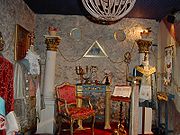
Château de Mongenan
Encyclopedia
The Château de Mongenan is an 18th century folly
and botanical garden
in Portets
, in the Gironde
Department of France. The gardens are classified by the Committee of Parks and Gardens of the French Ministry of Culture as among the Notable Gardens of France
.
The Château de Mongenan has been listed as a Monument historique
since 2003
 The Château de Mongenan was built in 1736 and the botantical gardens created in 1741 by the Baron de Gasq, inspired by his friend and music teacher Jean-Jacques Rousseau
The Château de Mongenan was built in 1736 and the botantical gardens created in 1741 by the Baron de Gasq, inspired by his friend and music teacher Jean-Jacques Rousseau
and the theories of the botanist Linnaeus, who believed that all plants were valuable, whether they were ornamental, medicinal, wild, or for food. The garden was made to resemble the ideal pre-romantic garden Rousseau described in Julie, la nouvelle Héloïse, full of aromas and colors. The current garden is kept as it was in the 18th century, with vegetables of the era, local varieties of fruit trees, 18th century varieties of roses, asters, iris
, dahlia
s, aromatic plants, and plants used to make perfume
. The park also includes tuberose
s and jasmine
.
The Château also houses a museum on Freemasonry
.
Folly
In architecture, a folly is a building constructed primarily for decoration, but either suggesting by its appearance some other purpose, or merely so extravagant that it transcends the normal range of garden ornaments or other class of building to which it belongs...
and botanical garden
Botanical garden
A botanical garden The terms botanic and botanical, and garden or gardens are used more-or-less interchangeably, although the word botanic is generally reserved for the earlier, more traditional gardens. is a well-tended area displaying a wide range of plants labelled with their botanical names...
in Portets
Portets
Portets is a commune in the Gironde department in Aquitaine in southwestern France.-Population:-See also:*Château de Mongenan, a chateau and botanical garden*Communes of the Gironde department-External links:*...
, in the Gironde
Gironde
For the Revolutionary party, see Girondists.Gironde is a common name for the Gironde estuary, where the mouths of the Garonne and Dordogne rivers merge, and for a department in the Aquitaine region situated in southwest France.-History:...
Department of France. The gardens are classified by the Committee of Parks and Gardens of the French Ministry of Culture as among the Notable Gardens of France
Notable gardens of France
The Remarkable Gardens of France is intended to be a list and description, by region, of the over two hundred gardens classified as "Jardins remarquables" by the French Ministry of Culture and the Comité des Parcs et Jardins de France...
.
The Château de Mongenan has been listed as a Monument historique
Monument historique
A monument historique is a National Heritage Site of France. It also refers to a state procedure in France by which national heritage protection is extended to a building or a specific part of a building, a collection of buildings, or gardens, bridges, and other structures, because of their...
since 2003
History

Jean-Jacques Rousseau
Jean-Jacques Rousseau was a Genevan philosopher, writer, and composer of 18th-century Romanticism. His political philosophy influenced the French Revolution as well as the overall development of modern political, sociological and educational thought.His novel Émile: or, On Education is a treatise...
and the theories of the botanist Linnaeus, who believed that all plants were valuable, whether they were ornamental, medicinal, wild, or for food. The garden was made to resemble the ideal pre-romantic garden Rousseau described in Julie, la nouvelle Héloïse, full of aromas and colors. The current garden is kept as it was in the 18th century, with vegetables of the era, local varieties of fruit trees, 18th century varieties of roses, asters, iris
Iris (plant)
Iris is a genus of 260-300species of flowering plants with showy flowers. It takes its name from the Greek word for a rainbow, referring to the wide variety of flower colors found among the many species...
, dahlia
Dahlia
Dahlia is a genus of bushy, tuberous, perennial plants native to Mexico, Central America, and Colombia. There are at least 36 species of dahlia, some like D. imperialis up to 10 metres tall. Dahlia hybrids are commonly grown as garden plants...
s, aromatic plants, and plants used to make perfume
Perfume
Perfume is a mixture of fragrant essential oils and/or aroma compounds, fixatives, and solvents used to give the human body, animals, objects, and living spaces "a pleasant scent"...
. The park also includes tuberose
Tuberose
The tuberose is a perennial plant related to the agaves, extracts of which are used as a middle note in perfumery. The common name derives from the Latin tuberosa, meaning swollen or tuberous in reference to its root system. It consists of about 12 species...
s and jasmine
Jasmine
Jasminum , commonly known as jasmines, is a genus of shrubs and vines in the olive family . It contains around 200 species native to tropical and warm temperate regions of the Old World...
.
The Château also houses a museum on Freemasonry
Freemasonry
Freemasonry is a fraternal organisation that arose from obscure origins in the late 16th to early 17th century. Freemasonry now exists in various forms all over the world, with a membership estimated at around six million, including approximately 150,000 under the jurisdictions of the Grand Lodge...
.

